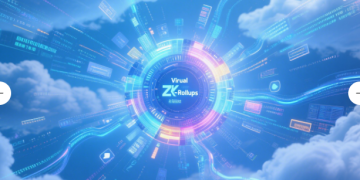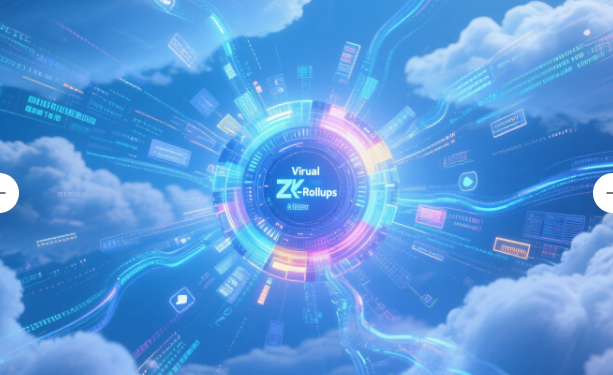In the fast-paced world of decentralized finance (DeFi) and blockchain technology, scalability remains a critical challenge. Ethereum, the leading smart contract platform, faces persistent congestion, high gas fees, and limited transaction throughput. Enter Virtual zk-Rollups—a groundbreaking Layer 2 scaling solution that leverages zero-knowledge (ZK) proofs to address these pain points while maintaining security and decentralization. This article explores how Virtual zk-Rollups are reshaping the blockchain landscape, backed by expert insights and real-world data.
The Mechanics of Virtual zk-Rollups
Virtual zk-Rollups operate by processing transactions off-chain in batches, significantly reducing the load on the Ethereum mainnet. Each batch generates a ZK-SNARK (Succinct Non-Interactive Argument of Knowledge), a cryptographic proof that validates the entire transaction set without revealing sensitive details . This proof is then submitted to the main chain, ensuring transparency and security while minimizing data storage requirements.
For instance, StarkWare’s StarkEx—a prominent zk-Rollup implementation—has processed over 42 million transactions with a peak throughput of 9,000 TPS (transactions per second), achieving a 600x scalability improvement over Ethereum’s base layer . Such efficiency makes zk-Rollups ideal for high-volume applications like decentralized exchanges (DEXs) and NFT marketplaces.
Balancing Speed and Security: How Virtual zk-Rollups Redefine Trust Models
Unlike Optimistic Rollups, which rely on a 7-day fraud-proof challenge period, Virtual zk-Rollups offer instant finality through ZK proofs. This eliminates withdrawal delays and reduces counterparty risk, making them particularly attractive for DeFi protocols where real-time asset movement is critical . Ethereum co-founder Vitalik Buterin has emphasized that zk-Rollups will likely dominate Layer 2 solutions long-term due to their capital efficiency and superior security guarantees .
However, the complexity of ZK cryptography poses challenges. Building EVM-compatible zk-Rollups requires rewriting smart contracts in specialized languages like Cairo (used by StarkNet) or optimizing existing code for ZK-friendly computation . Projects like zkSync Era and Polygon zkEVM are addressing this by developing EVM-equivalent zk-Rollups, allowing developers to reuse Ethereum’s vast ecosystem while enjoying scalability benefits .

Overcoming Technical Hurdles: The Path to Mainstream Adoption
While Virtual zk-Rollups promise transformative scalability, they face validation time constraints and computational costs. For example, generating ZK proofs for complex smart contracts can take hours, though advancements like recursive proof aggregation and hardware acceleration (e.g., ZK-SNARK ASICs) are reducing this to minutes .
Another challenge is data availability. Unlike Optimistic Rollups, which store all transaction data on-chain, zk-Rollups rely on off-chain data storage, requiring robust mechanisms like Data Availability Committees (DACs) to prevent data loss . Projects like Celestia are exploring modular blockchain architectures to enhance data availability and interoperability across Rollups .
Real-World Impact: Use Cases and Success Stories
Virtual zk-Rollups are already powering innovative applications:
- DeFi: Platforms like dYdX use zk-Rollups to enable low-cost, high-speed derivatives trading, handling $185 billion in cumulative volume .
- NFTs: Immutable X leverages zk-Rollups for gas-free minting and trading, supporting popular projects like Sorare .
- Privacy: zk-Rollups’ inherent privacy features are being adopted by protocols like Aztec Network, which enables private DeFi transactions without compromising security .
According to a 2025 industry report, zk-Rollups are projected to handle 20,000 TPS and reduce proof generation costs by 90%, driven by advancements in AI-optimized algorithms and decentralized prover networks .
The Future of Virtual zk-Rollups
As the blockchain ecosystem evolves, Virtual zk-Rollups are poised to become the backbone of scalable, secure decentralized applications. The Ethereum Foundation’s ongoing research into Type 1 ZK-EVMs—which aim for full EVM equivalence without compromising ZK efficiency—could unlock seamless compatibility with existing tools and infrastructure .
For developers and users alike, staying informed about these advancements is crucial. Platforms like Bitora provide real-time insights into zk-Rollup trends, project updates, and market analysis, empowering stakeholders to make data-driven decisions in this rapidly evolving space.
Stay ahead with Bitora’s real-time insights into the evolving world of Virtual zk-Rollups.
Author Biography
Sarah Chen is a leading authority on blockchain scalability and decentralized finance. With over a decade of experience in fintech and cryptography, she has advised major DeFi protocols and contributed to research on zero-knowledge proofs. Sarah holds a Ph.D. in Computer Science from MIT and has published widely on Layer 2 solutions and Web3 infrastructure. Her work focuses on bridging technical innovation with practical adoption, ensuring blockchain technologies meet the needs of both developers and end-users.



























